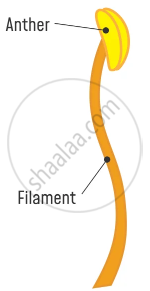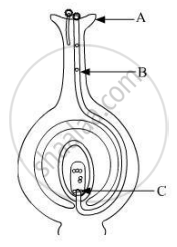Advertisements
Advertisements
Question
Name the reproductive parts of an angiosperm. Where are these parts located? Explain the structure of its male reproductive part.
Solution
The stamen and pistil are the reproductive parts of an angiosperm. They are located in the flower.
Stamen is the male reproductive part of a flower. A stamen consists of anther and filament.

Structure of Stamen
- Anther: Anther is a sac-like structure that produces pollen grains.
- Filament: Filament is a thin stalk-like structure that supports anther.
RELATED QUESTIONS
Name the parts A, B and C shown in the diagram and write their functions.

The reproductive part of a plant is the ______.
In tobacco plant, the male gametes have 24 chromosomes.
What is the number of chromosomes in the zygote?
Which of the following is the correct sequence of events of sexual reproduction in a flower?
(a) pollination, fertilisation, seed, embryo
(b) seed, embryo, fertilisation, pollination
(c) pollination, fertilisation, embryo, seed
(d) embryo, seed, pollination, fertilisation
Which among the following statements are true for unisexual flowers?
(i) They possess both stamen and pistil
(ii) They possess either stamen or pistil
(iii) They exhibit cross pollination
(iv) Unisexual flower possessing only stamens cannot produce fruits
(a) (i) and (iv)
(b) (ii), (iii) and (iv)
(c) (ii) and (iii)
(d) (i), (iii) and (iv)
Fill in the blanks:
A carpel consists of ________ , ________ and ________.
State whether the following statement is true (T) or false (F):
Stamens make egg cells.
Mention the function of Anther.
A student is asked to study the different parts of an embryo of pea seeds. Given below are the essential steps for the experiment :
(I) Soak the pea seeds in plain water and keep them overnight.
(II) Cut open the soaked seed and observe its different parts.
(III) Take some pea seeds in a petri dish.
(IV) Drain the excess water. Cover the seeds with a wet cotton cloth and leave them as it is for a day.
The correct sequence of these steps is
(A) III, I, IV, II
(B) III, IV, I, II
(C) III, I, II, IV
(D) III, II, I, IV
In a flowering plant, archesporium gives rise to ______.
